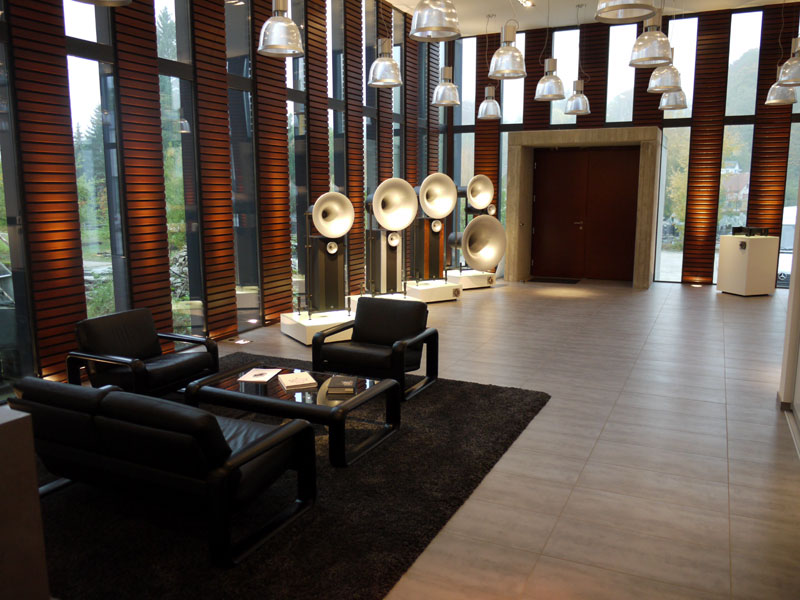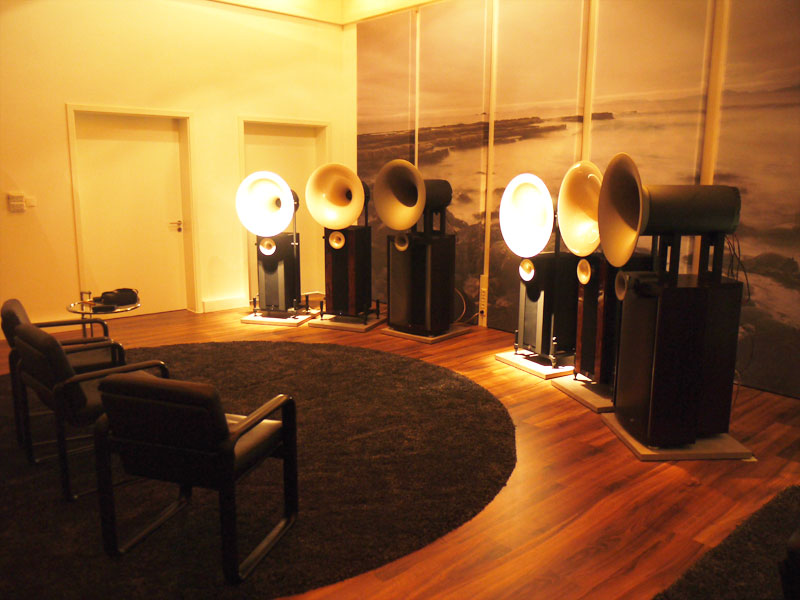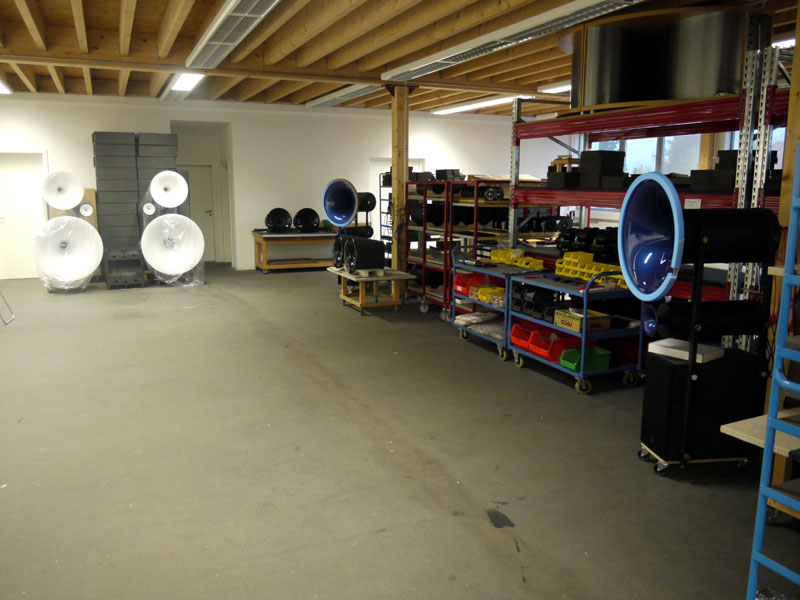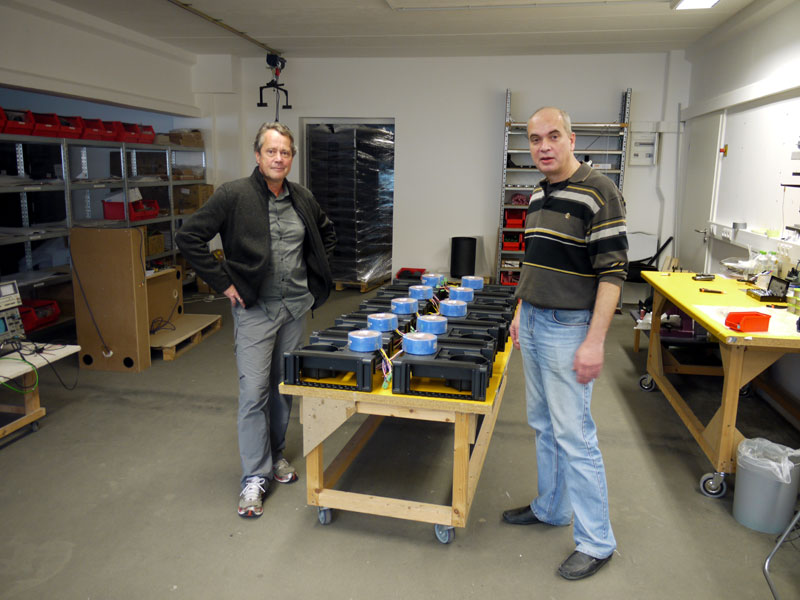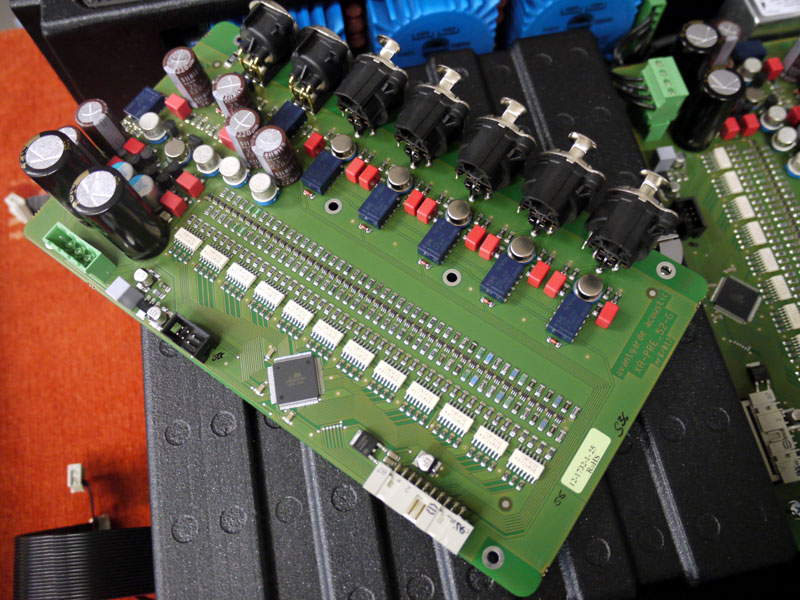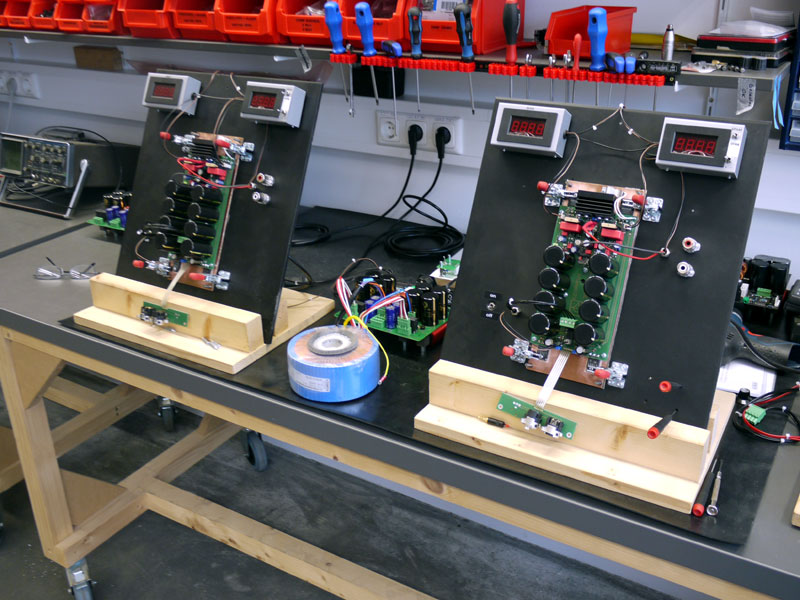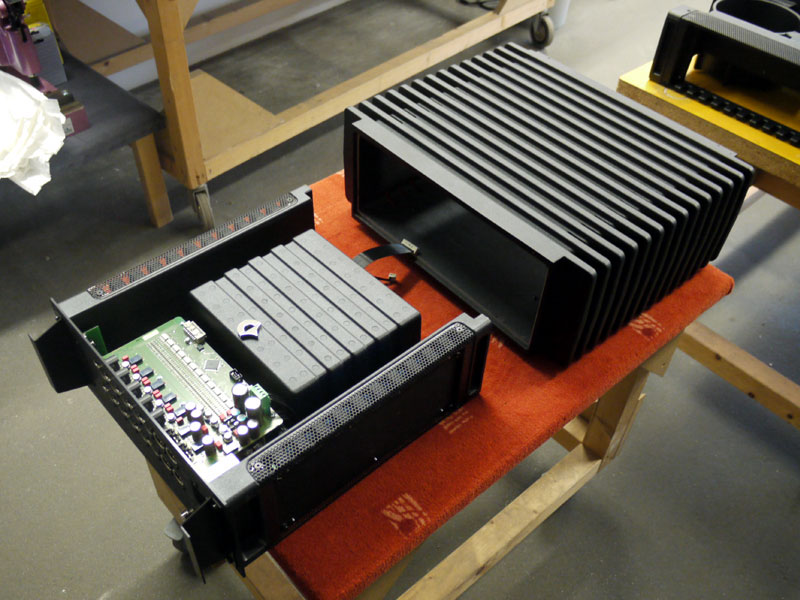Inside
Avantgarde
vantgarde may not have been the first company to use spherical horns for hi-fi applications, but the company was certainly the one that took the concept furthest, extending it across a wider bandwidth and broader market than anybody before or since. In truth, those massive, brightly colored trumpets are hard to miss, even the company’s smaller models making a serious aesthetic statement. But that powerful visual identity has been something of a double-edged sword, occasionally leading customers and commentators to dismiss the approach as a gimmick. That would be a mistake. If I were to list the ten best systems I’ve ever heard, two of them would have Avantgarde’s flagship Trios on the business end. If I were to list the ten worst (and you know what’s coming), two of them would also have Trios doing the talking. Therein lies a tale, but it’s one that’s well worth hearing. Avantgarde was the brainchild of one Holger Fromme. A man with a serious background in technology marketing, he also had a passion for music and the audio equipment that re-creates it in your home. That eventually led to his creative partnership with designer/engineer Matthias Ruff and the founding of Avantgarde Acoustic. They were totally convinced about the rightness of their design path and overall concept, but the realities of making and selling high-end audio products came as something of a shock -- especially given the demonstrable qualities of the product. Now, nearly 30 years after the first Avantgarde speakers saw the light of day, changes in the market and a strategic reappraisal see Avantgarde take several significant strides aimed at preparing the company to meet the challenges of the new audio reality. An important part of that process involved a reappraisal of what exactly the Avantgarde brand stands for. The answer can be summed up in the simple phrase "Purity Meets Performance": purity of philosophy and concept, structure and execution -- all in the service of maximizing performance. It’s a phrase that peppers the company’s website and literature and which one might easily pass over as mere marketing hyperbole, but even a cursory glance at the products themselves does ram the point home. One look at the skeletal frame that holds the various parts of any Avantgarde speaker should tell you that there’s an almost Bauhaus minimalism at work here -- one look at the massive stack of bass horns that underpins their flagship system should leave you in no doubt that these people are serious about performance and about achieving it without compromising their principles. That purity of purpose has in turn led them to make what might seem like a surprising decision. Ask yourself how many dealers would a company like Avantgarde normally expect to have in its home market -- the large and extremely committed German market in Avantgarde's case? I’m guessing the answer wouldn’t be two, with one of those being the company itself.
Avantgarde’s impressive new showroom.
In fact, what at first might seem like a surprisingly small number makes considerable sense, a sense that has far wider implications for the audio industry as a whole. An essential aspect of the "Purity Meets Performance" mantra is actually delivering that performance, not just in theory but also in practice -- and that means doing it in the customer’s home. Think back to my opening observation about just how rewarding and disappointing the Avantgarde speakers can be and the problem becomes clear. Capable of great things, they are also equally capable of letting you know when things aren’t as good as they should be. The lack of dynamic compression and sheer immediacy, combined with the phase coherence delivered by the spherical horns and simple first-order crossovers means that any discontinuity or non-linearity in the driving system, any inadequacy in the speakers’ setup will be ruthlessly revealed. Where the losses inherent in more conventional speakers paper over the cracks, making those failings less obvious (just more insidious), they are brutally apparent when heard through the wide-open window of a high-efficiency horn. Add in the hybrid nature of the Avantgarde designs, with their reliance on active subwoofers, with all but the top models relying on sealed boxes to generate their low frequencies, and the challenge they present becomes even more obvious. It’s one thing to buy an Avantgarde speaker, but getting it to work well can be quite another. Now, given that the Avantgarde speaker systems start on the wrong side of €10,000, that’s really not acceptable. Anybody sitting down in front of a system that costs as much as quite a nice car (by the time you add in the driving electronics) should be blown away. Full marks to Avantgarde for recognizing the inconvenient realities of the situation and doing something about it. The sad truth is that although the problem might be more apparent with a horn-loaded hybrid loudspeaker, it actually afflicts high-end audio as a whole. Too often the systems that people hear (and own) are simply failing to deliver on the promises made for them. Avantgarde’s response was to reduce their dealer network to the point where they could guarantee that anybody who sought out their products was going to get the best possible demonstration, underpinned by the necessary knowledge and practical experience to extend that listening experience into the customer’s own system and setup. But it goes further than that. Having the well of experience, the system and the personnel necessary to present your products properly, it’s also helpful to create an impressive environment in which customers can listen -- one that reflects the design ethos and qualities of the products themselves. This is exactly what Avantgarde have done, creating an expansive new showroom and listening space adjacent to their production facility. It’s an impressive space with a layout and décor that show the speakers to best advantage. No cluttered racks full of dusty electronics here. Instead, the entire Avantgarde range is on show, beautifully presented in a clean, expansive space, more art gallery than showroom. The color coordination of the "exhibits." the white walls and relaxed seating and bar area all add to the impression, an interior that has more to do with Ligne Roset or Roche Bobois than it does with the average high-end audio store. Which is exactly the point.
The listening room offers the opportunity to compare and contrast no fewer than seven different models.
The careful, tasteful presentation extends through the broad door giving access to the darker hues of the listening room, where you’ll find not just the massive Trio speaker system, along with a six-pack of bass horns on permanent demonstration, but no fewer than six other speaker systems representing almost all the range, although not all the permutations possible within it. Of course, if you want to audition the Trios with a pair of SUB231 bass units, or maybe the Short Basshorns, that too is possible -- the beauty of having your factory and warehouse right next door. And talking of production
n many respects, once you’ve seen one loudspeaker factory you’ve seen them all. But the Avantgarde facility does have a few notable differences. The first thing you’ll notice is that the modular nature of the speakers themselves means that the process revolves around the creation of subassemblies. These couple the unusual drivers specific to the spherical-horn designs to the cylindrical cabinets that load them. The horns themselves are molded offsite before being cleaned, finished and then sprayed in-house. Meanwhile, active-subwoofer cabinets are assembled separately, creating sealed-box units complete with their own internal electronics. The final parts of this complicated jigsaw are the speaker frame components, bases and uprights that are assembled around the speaker modules themselves. The other unusual aspect of the factory layout is the massive open space given over to building and packing speakers. With no fewer than eleven standard finishes for the trumpets and a range of sixteen colors or veneers for the bass cabinets, the range of options is mind boggling, making each speaker a bespoke project. Add to that the fact that the speakers are shipped fully assembled and the need for a large, open space becomes clear. Think in terms of building a child’s climbing frame from a kit of parts and you won’t go far wrong.
Building Avantgarde speakers demands a lot of space -- and a lot of parts.
While it’s fair to say that the Avantgarde range has evolved rather than been revolutionized (the initial lineup of Uno, Duo, and Trio models still forms the framework, albeit filled out with multiple Duo variations and with the mighty Basshorns added at the top) one of the key refinements becomes apparent during assembly. Where frame components on the early speakers were functional but [ahem] a little agricultural, the recent G2 revisions have elevated the fit and finish of frame elements and fasteners to the same level as every other component in the speaker. From the cast outrigger bases with their beautifully knurled spike adjusters, to the thumbscrews that fix the speaker modules in place, each element is now as refined and elegant as the whole. There are no corners cut here, and the speakers look as impressive close up as they do from a distance. It’s an important consideration when offering expensive products to discerning buyers -- buyers who are used to enjoying the detail and finishing touches on other high-quality products. Likewise, despite the extensive range of standard finish options, the bespoke nature of the product lends itself to personalization and special-order colorways. A beautiful pair of Trios with matte-white horns were awaiting delivery as I toured the factory; they looked fantastic and they’d fit right in at home -- although I’m not sure I’d like the job of keeping them clean. Apparently, matte finishes are all the rage in the Far East, as witnessed by the striking orange and red pair of Duo Mezzos gracing the showroom. Getting serious about systems
vantgarde’s speakers are kind of hard to miss, but the company's past forays into electronics have remained, if not exactly under the radar then at least on the fringes of the market. The original Model 5 integrated amp was a diminutive yet stylish device intended to offer basic, benchmark performance with ultra-sensitive horn speakers. Its ovoid fascia cutout and retro needle indicators set it apart, and so did its sound. Remember my comments about just how revealing the Avantgarde speakers are, and how unforgiving they can be? The Model 5 was intended to overcome that issue in dealer demonstrations. If the shop had something better, then all well and good, but if not, the little integrated could be relied upon to demonstrate the speakers’ true capabilities. Next up were the mighty Model One preamp and power amplifier, ambitious cost-no-object designs with a novel 50-watt class-A, single-ended, solid-state topology and beautifully sculpted casework -- and the sort of price tag where if you had to ask. . . . They were followed by the equally beautiful but far more affordable Model 3 integrated, a design that only recently gave way to the new XA designs. Yes, that’s right: Avantgarde are back in the electronics business, but this time they’re offering more, much more, than just an affordable standby in case your existing amps disappoint. The XA preamp and power amp will, of course, work wonders with Avantgarde’s own speakers, but these are genuinely universal designs that seek a far wider audience. Naturally, being Avantgarde designs, the amps are far from ordinary. One look at the sensitivity of the speakers and some familiarity with the sort of amplification most often used with horn systems might well lead you to expect some flea-powered triode design, but nothing could be further from the facts. The XA is a stunningly executed solid-state combination, as innovative in circuit topology as it is in assembly.
The sensitivity of the spherical horns makes them critically revealing of compression, grain or timing errors caused by inadequate power-supply quality -- either the power supply feeding the system or the ones inside its amplifiers. Likewise, the dynamic integrity of the speakers has always led the company towards ultra-fast solid-state designs. The downside is the cross-zero switching distortion that is all too audible in class-AB designs. You can overcome that by using the sort of class-A circuitry found in the Model One power amp, but it is a complex and costly solution ill-suited to series production. Incorporating class-A circuitry into any amplifier with the power delivery and price tag to make it a genuinely universal offering is hard indeed, if not impossible. Finally, they were all too aware of the damage done by mechanical vibrations within audio circuits -- another indication of just how critically revealing the horn speakers are of system performance and shortcomings. Avantgarde’s solutions to these problems are exactly the combination of innovation and sound engineering that you’d expect. Faced with three discrete challenges (AC-supply quality, cross-zero distortion and mechanical degradation) the XA project approached each in turn. Of course, the easiest way to deal with a problem is to eliminate it altogether, which is exactly what the XA-Pre does in the case of its AC supply. The center of the unit’s substantial chassis is occupied by a massive and extremely sophisticated battery power supply, an approach that delivers a pure DC circuit environment that enjoys complete galvanic isolation. But batteries aren’t practical in a genuinely powerful amplifier, and the XA-Power is rated at 150Wpc, so instead multiple layers of filtering and regulation are used, in conjunction with a considerable power-supply storage capacity. Just take a look at the picture of the amplifier boards on the test jig (below). The main supply is on the central board (placed horizontally) while the left- and right-channel boards are offered up for trimming adjustments. Around 80% of what you can see on each board is secondary power supply, the top inch or so representing the actual output stage! When someone describes an amplifier as 95% power supply, the XA-Power would offer the perfect example. Circuit topology is fully complementary throughout, with no single-ended inputs or outputs, helping to keep noise levels to a minimum -- essential when driving really efficient speakers, but desirable in any audio system. But the really innovative aspect of the circuit is the DC-Flow topology, in which the entire signal path is flooded with a standing level of DC. Active devices operate in variation to the DC reference current, thus eliminating the zero crossing point. It’s a patented solution that Avantgarde are quietly proud of, one that promises great things.
The fully complementary preamp board, showing the resistor ladder used for volume control.
But by far the most physically obvious step change in design lies in the amplifiers’ approach to mechanical interference, through the construction of the XA chassis. Each unit is built around a massive, three-dimensional cast-aluminum monocoque. As always, a picture is worth a thousand words, so take a look at the accompanying images and you’ll get the idea. Each casting is essentially a deep, squared-off W shape, the outer arms forming the sides of the chassis, the central hump a deep, all-enveloping well into which the batteries for the preamp or the toroidal transformer for the power amp are mounted from below.
The troughs between the central hump and the sides create pockets to which are directly mounted the circuit boards, or in the preamp the potted transformers to feed the control and charging circuitry. Slide the chassis into a second cast sleeve, bolt on the front and rear panels, along with their associated circuitry (power supply and filtering in the power amp, switching and volume control in the preamp) and you are left with a single, incredibly solid lump, built onto the spine of the massive inner and outer castings -- each unit weighs in at over 90 pounds! The various structural demands of the two different designs in turn dictate the need for totally separate internal monocoques, calling for three casting tools in all -- an incredibly high up-front cost. But, as Matthias Ruff is quick to point out, milling such complex shapes from solid material would result in a huge unit cost, whereas once the tools are paid for, the individual cost of the castings is far lower, as well as the stress-free structure that results from having superior mechanical behavior. Besides which, Avantgarde have been working with castings and injection moldings from day one, so they are used to the high up-front cost and subsequent savings. For them it is business as usual -- which doesn’t stop the elegant simplicity of the XA amplifiers’ nested construction from being any less impressive. Throw in a range of finish options and variations that allow you to match the amps to your Avantgarde speakers, your décor or pretty much anything else that takes your fancy and you have a pair of strikingly impressive products.
The preamp chassis ready to be inserted into its cast outer sleeve.
In keeping with the Avantgarde philosophy, the electronics are unashamedly straight-line, literally allowing you to select an input and set the level. A sophisticated set of LED options displays status, volume, etc., while the funkiest remote control ever allows you to set the level and mute the system (as well as own the nearest thing you’ll ever get to your own light sabre). The electronics should be turning up for review shortly, and not surprisingly I’m keenly anticipating their arrival. For a company whose products are so visible and instantly identifiable, the charming and engaging people from Avantgarde are strangely yet confidently quiet in person. Perhaps it comes from the sure and certain knowledge that loud simply won’t be a problem, but more likely it is that powerful combination of dedication, genuine passion and total confidence in their chosen path. It’s a confidence that has been built on the longevity and performance of the original designs and concept, but it has received a significant recent boost through the complete reassessment of their business model and practices. "Purity Meets Performance" might be a catchy marketing slogan, but it also sums up every aspect of the company, every single thing they do. Perhaps the best example of all lies in their website,
which is a far cry from the shabby, clunky presentation achieved by most niche producers.
It’s worth a look,
and when you’ve done that, ask yourself a simple question: would the people
responsible for putting this together put any less effort or attention to detail into the
products they design and build? The answer should be obvious, but just in case of any
lingering doubts, I’ve been fortunate enough to take the tour, and I can definitely
confirm that as far as Avantgarde are concerned, the term "commitment" barely
scratches the surface. High-end in thinking and in practice, there are lessons here that
high-end audio as a whole could benefit from. |

